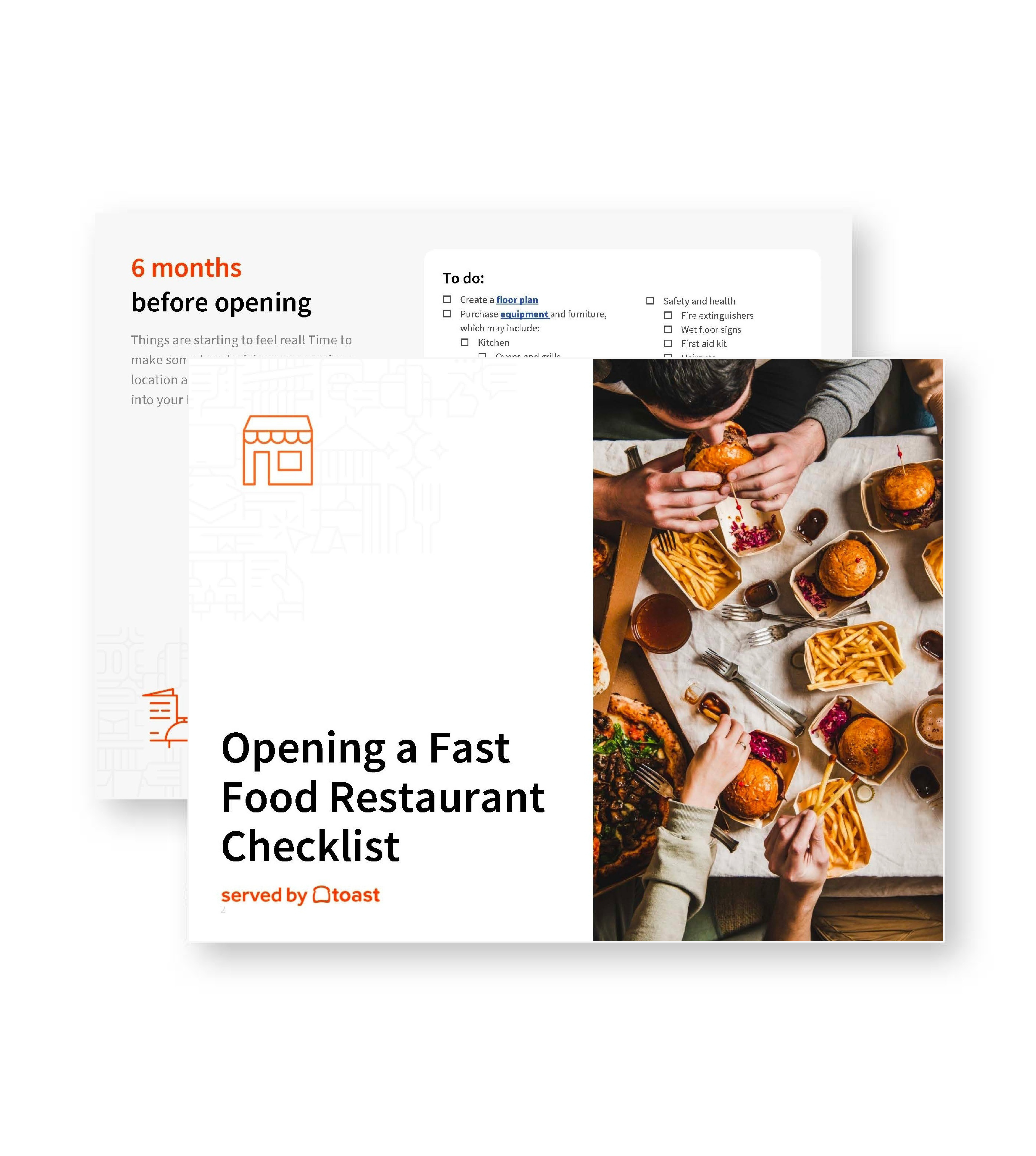
The Rising Cost of Convenience: Is Fast Food Too Expensive in 2025?
Let's take a look at how fast food prices are changing in 2025.
Caroline PriceAuthor

Opening a Fast Food Restaurant Checklist
So many things go into opening a fast food restaurant. With this free PDF checklist, you'll set your new business up for success.
Get Free Download | Built for Restaurants
| Built for RestaurantsFast food has long represented an affordable dining option for millions of Americans seeking quick, convenient meals. Now, across the country, Americans stare at menu boards, watching prices climb higher with each visit, and ask a question that once seemed unthinkable: why is fast food so expensive now?
The industry built its empire on the promise of good value – satisfying food at prices accessible to virtually everyone. However, in recent years, particularly since the pandemic, consumers have experienced significant sticker shock at drive-thru windows nationwide, questioning whether fast food has lost its budget-friendly appeal.
Has the economics of fast food fundamentally changed, or are we witnessing a temporary adjustment in a post-pandemic economy? Let’s dive in.
The new reality of higher prices
The landscape of fast food prices has transformed dramatically. McDonald's, once the standard-bearer for affordable quick-service dining, has seen substantial price increases. The average price of a Quarter Pounder with cheese is now $5.39, up 20% from $4.49 in 2019, while a 10-piece McNuggets meal costs $9.19, up 28% from $7.19 five years ago, according to a letter from McDonald's USA President Joe Erlinger.
The nationwide average cost of a Big Mac in summer 2023 was $5.58, representing more than a 10% increase from the $4.89 it cost in December 2020, according to an index run by the Economist. While these figures represent national averages, prices can be substantially higher in certain locations, with a Big Mac combo meal costing around $18 in wealthy areas like Darien, Connecticut.
This phenomenon isn't limited to the golden arches.
According to data collected by FinanceBuzz, from 2014 to 2024, average fast food menu prices rose between 39% and 100% across major chains – all increases that outpaced the overall inflation rate during that period (31%). The study found that McDonald's menu prices doubled (100% increase) since 2014, the highest of any chain analyzed, with Popeyes following at 86% and Taco Bell at 81%.
Factors driving the surge
Multiple converging factors have contributed to the steep rise in fast food prices. Labor costs represent a significant component, with Stephens analyst Jim Salera noting that "what continues to be ahead of historical averages is the increase in labor costs that restaurants are seeing."
Rising labor costs are particularly significant in states implementing higher minimum wages. In some states, food chains with at least 60 locations nationwide are required to raise the minimum wage for restaurant employees to $20 per hour. These wage increases have led fast food chains to adjust their pricing strategies accordingly.
Supply chain challenges, which began during the pandemic, have continued to affect the industry in various forms. According to a March 2024 report by the Federal Trade Commission, higher operating costs, supply chain disruptions, and corporate profits have all contributed to high food prices since 2019.
Corporate profit strategies have also played a role. A study by Finance Buzz analyzing menu price data across twelve top fast-food chains between 2014 and 2024 found that most restaurants raised prices by 60% on average during that period, with five chains – McDonald's, Popeyes, Taco Bell, Chipotle, and Jimmy John's – doing so at more than double the actual inflation rate.
The return of value menus
The fast food industry has noticed consumer pushback against rising prices and has responded with new value offerings. McDonald's announced its new McValue platform that launched on January 7, 2025, extending its popular $5 Meal Deal through summer 2025. The deal includes a choice of a McDouble or McChicken sandwich, four-piece chicken McNuggets, small fries, and a small soft drink.
Other chains have followed suit. Taco Bell announced new value boxes starting January 16, 2025, that cost $5, $7, and $9, available through early June. Subway launched a "Meal of the Day" menu with a different special each day of the week, offering a six-inch sub for $6.99 with a drink and side. Wendy's introduced a "2 for $7 deal" that was available until March 2, 2025, allowing customers to pick two popular food items for $7, including options like the Spicy Chicken Sandwich and 10-piece Nuggets.
These value initiatives aim to recapture budget-conscious consumers who have reduced their fast food consumption due to rising prices. However, industry analysts remain cautious about their impact. In a quarterly survey of McDonald's franchisees, analyst Mark Kalinowski of Kalinowski Equity Research found that the $5 meal deal helped sales by just 1.3% on average, suggesting it "should be viewed as an initiative that may help prevent some customers from going elsewhere, as opposed to a big sales builder."
Consumer response and adaptation
Americans have responded to these price hikes in various ways. According to a 2024 survey conducted by LendingTree, 78% of consumers now consider fast food a "luxury" purchase due to its increasing cost. Many have reduced their fast food consumption or become more selective about when and where they indulge.
The socioeconomic impact is particularly significant for low-income consumers. Wendy's Chief Financial Officer Gunther Plosch told analysts in May 2024 that "the consumer is still under pressure," noting that visitation is down in lower-income households while traffic is up among higher-income consumers, who are trading down for more affordable options.
Some consumers have turned to grocery stores, finding that preparing meals at home, even accounting for time investment, offers better value. According to a recent study by Toast, 79% of shoppers said that going grocery shopping and cooking at home is where they get the most value for their time and spend.
Grocery delivery services have capitalized on this trend, creating ready-to-heat meal options that compete directly with fast food on convenience while offering better value. According to Drive Research, the use of grocery delivery services in 2024 rose by 56% compared to 2022.
Industry response
Fast food executives have defended price increases as necessary given rising costs.
In response to California's 2024 wage increases, Chipotle's CFO Jack Hartung told Yahoo Finance that the company would have to raise prices in the mid- to high-single-digit range. And, Portillo's CEO Michael Osanloo noted, "When California says everybody's got to make 20 bucks, we can't just go to 20 bucks. ... We're going have to pay more than 20 bucks.” He also added that this “means prices in that market have to be such that the margins are the same in California versus Minnesota versus Texas versus Florida."
Looking forward, the industry is focusing on value strategies to reinvigorate traffic and sales. Several fast food chains are offering new value menus and discounts in 2025 as a response to tightening consumer budgets. This represents a significant shift from recent years when chains emphasized premium offerings and experience-based dining.
Economic implications
The rising cost of fast food has broader economic implications. For decades, the sector has served as a reliable indicator of everyday affordability. When a quick meal at a drive-thru approaches $15, it signals meaningful inflation in everyday life.
Economists David Andolfatto and David Kelly emphasize that high food prices affect people in the low-income bracket the most, as "lower-income quintiles spend proportionately more of their budget on food and shelter than higher-income quintiles."
The cost to dine out is outpacing grocery inflation. In December 2023, while the price of groceries rose by 1.3%, the cost of food away from home (restaurants) increased by 5.2%, according to Citi analyst Jon Tower, who noted that "when labor inflation runs ahead of commodity inflation, restaurant prices tend to outpace grocery pricing."
Looking forward
As we progress through 2025, the fast food industry continues to navigate the tension between maintaining profit margins and offering the value proposition that built its businesses. The fundamental question remains: At what point does fast food cease to be "fast food" in the traditional sense – quick, convenient, and affordable?
According to the USDA Economic Research Service, food price growth continued to slow in 2024, rising by 2.3% compared to 5.8% in 2023, with food-at-home prices increasing by just 1.2% – lower than their historical average pace of growth. This could signal some relief ahead, though factors like higher labor costs remain.
For now, Americans are adjusting to the new reality where convenience comes at an increasingly premium price. The current wave of value menu offerings suggests that fast food chains recognize they've reached a tipping point with consumers and are attempting to recalibrate their price-value equation.
In this evolving landscape, the most successful chains will likely be those that can strike the right balance between profitability and affordability, finding innovative ways to deliver value without sacrificing quality. For consumers, especially those in lower income brackets, these developments will determine whether fast food remains an accessible option or becomes an occasional indulgence in their food budget.
Is this article helpful?
DISCLAIMER: This information is provided for general informational purposes only, and publication does not constitute an endorsement. Toast does not warrant the accuracy or completeness of any information, text, graphics, links, or other items contained within this content. Toast does not guarantee you will achieve any specific results if you follow any advice herein. It may be advisable for you to consult with a professional such as a lawyer, accountant, or business advisor for advice specific to your situation.
Read More
Subscribe to On the line
Sign up to get industry intel, advice, tools, and honest takes from real people tackling their restaurants’ greatest challenges.
By submitting, you agree to receive marketing emails from Toast. We’ll handle your info according to our privacy statement. Additional information for California residents available here.



